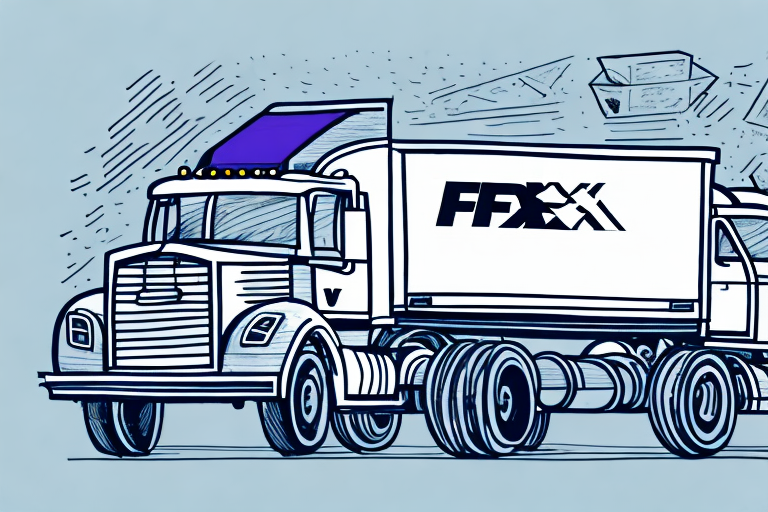Understanding Weight-Based FedEx Shipping Rates: A Comprehensive Chart
When you need to send a package, ensuring its quick and cost-effective delivery is paramount. FedEx is a leading shipping carrier that offers a wide range of services, from express overnight deliveries to ground shipping. To help you make informed decisions about shipping costs with FedEx, this article provides a comprehensive understanding of weight-based FedEx shipping rates.
How to Calculate Shipping Costs for Your Packages with FedEx
Before delving into weight-based shipping rates, it's essential to understand how to calculate shipping costs with FedEx. Shipping costs are influenced by several factors, including package weight, dimensions, distance, and delivery time. To accurately calculate shipping costs with FedEx, you need the package's weight, dimensions, origin and destination ZIP codes, and the desired delivery service type. Utilize FedEx's online shipping calculator or consult a FedEx shipping expert for precise estimates.
FedEx offers various delivery service types, each with distinct shipping costs and delivery times. For instance, FedEx Express provides overnight, 2-day, and 3-day delivery options, while FedEx Ground offers standard delivery within 1-5 business days. The chosen delivery service type significantly affects the shipping cost, so it's crucial to consider the urgency of your package and your budget when selecting a service.
The Difference Between Weight-Based and Dimensional Weight Shipping Rates
FedEx calculates shipping costs using both weight-based and dimensional weight rates. While weight-based rates rely on the package's actual weight, dimensional weight rates consider the package's size and density. Dimensional weight is determined by multiplying the package's length, width, and height, then dividing the result by a predetermined divisor (typically 139 for domestic shipments). The higher value between the actual weight and dimensional weight is used to calculate the shipping cost. Understanding your package's dimensional weight is crucial to avoid unnecessary expenses.
Dimensional weight rates often apply to larger, lightweight packages that occupy significant space. Carriers like FedEx aim to maximize the number of packages they can transport, especially on limited-space vehicles like trucks and planes. Consequently, shipping a large but lightweight item might incur higher costs than expected based on its actual weight. To prevent this, always measure and calculate the dimensional weight of your package before shipping.
How to Choose the Right Shipping Method for Your Business with FedEx
Selecting the appropriate shipping method hinges on your business needs. If speed is a priority, FedEx Express offers overnight and two-day delivery options. For cost-effective shipping of non-urgent packages, FedEx Ground is an economical choice. Both services utilize weight-based and dimensional weight shipping rates, making it essential to know your package's dimensions and weight to select the most suitable method.
Another critical consideration is the destination of your package. FedEx boasts a global network that reaches over 220 countries and territories. For international shipments, FedEx International Priority offers fast and reliable delivery options. Additionally, FedEx provides customs clearance services to ensure your package complies with all necessary international shipping regulations and requirements.
Understanding FedEx Express vs. Ground Shipping Rates
FedEx Express and Ground services have distinct shipping rates due to their different delivery times and service offerings. FedEx Express offers faster but more expensive shipping options, while FedEx Ground provides slower yet more cost-effective solutions. Both services apply weight-based and dimensional weight shipping rates, so comparing prices and delivery times is essential before making a choice.
Moreover, FedEx Express and Ground serve different delivery areas. FedEx Express includes international shipping, whereas FedEx Ground is limited to deliveries within the United States. FedEx Express also guarantees delivery times, a feature not available with FedEx Ground. If your package must arrive by a specific date, investing in FedEx Express shipping may be worthwhile.
How to Negotiate Shipping Rates with FedEx for Your Business Needs
For businesses with high-volume shipping requirements, negotiating shipping rates with FedEx can lead to significant cost savings. FedEx offers volume discounts to businesses that consistently ship large quantities, providing more affordable shipping solutions. To negotiate effectively, consult a FedEx shipping expert who can tailor shipping rates based on your specific business needs and shipping volume.
Preparation is key when negotiating shipping rates. Before approaching a FedEx representative, have a clear understanding of your shipping needs, including the number of packages you send, their destinations, and the required delivery speeds. This information aids the FedEx expert in crafting a shipping solution that aligns with your budget and operational requirements. Additionally, provide documentation supporting your shipping volume, such as invoices or shipping records. With thorough preparation and negotiation, you can secure competitive shipping rates that enhance your business's profitability.
Tips to Save Money on Your FedEx Shipping Costs
Implementing the following strategies can help you reduce your FedEx shipping expenses:
- Use a packaging service that offers discounted FedEx shipping rates
- Ship during off-peak times to take advantage of lower rates
- Compare FedEx rates with other shipping carriers like UPS and USPS to find the most economical option
- Opt for slower shipping options, such as FedEx Ground, when time permits
Additionally, consider enrolling in FedEx's loyalty program, FedEx Rewards. This program allows you to earn points for every eligible shipment, which can be redeemed for discounts on future shipments or gift cards to popular retailers. If you frequently ship to the same locations, setting up a FedEx account and negotiating customized rates based on your shipping volume and frequency can lead to further savings.
Understanding the Impact of Distance on Your FedEx Shipping Rates
Distance significantly affects shipping costs; the farther a package travels, the higher the shipping fees. Long-distance shipments consume more resources and require more transportation, leading to increased rates. FedEx's shipping rates escalate with distance, making it essential to consider the destination's proximity when calculating shipping costs.
Moreover, the weight and size of your package also influence shipping rates. Heavier and larger packages demand more space and resources, resulting in higher costs. To ensure accurate shipping costs, always measure and weigh your package before shipping it with FedEx.
The Pros and Cons of Using FedEx for Your E-commerce Business
FedEx offers a reliable shipping solution for e-commerce businesses, boasting robust tracking systems, fast delivery options, and competitive pricing. However, it may not be the ideal choice for every e-commerce operation. Small businesses might find FedEx's higher shipping rates challenging, potentially limiting access to its services. It's crucial to compare FedEx's rates and services with other shipping carriers to make an informed decision.
Another consideration is FedEx's delivery options. While FedEx excels in fast deliveries, it may not always deliver to certain locations or offer weekend delivery services. This limitation can be a drawback for businesses that require weekend deliveries or need to reach customers in remote areas. Thoroughly researching and understanding FedEx's delivery capabilities and restrictions is essential before selecting it as your primary shipping carrier.
A Detailed Comparison of FedEx vs. UPS Shipping Rates and Services
When selecting a shipping carrier, comparing FedEx's rates and services with those of competitors like UPS is vital. Both UPS and FedEx offer a range of shipping services and pricing structures, but there are key differences that might make one more suitable for your specific needs.
A primary difference lies in their approach to delivery times. FedEx provides a broader array of delivery options, including same-day, overnight, and two-day deliveries. In contrast, UPS emphasizes reliability and consistency, maintaining a strong track record for on-time deliveries. Depending on whether your business prioritizes speed or consistency, one carrier may better align with your requirements.
How to Track Your FedEx Shipments and Manage Delivery Expectations
FedEx offers advanced tracking tools that enable you to monitor your package's delivery status and manage delivery expectations effectively. Access these tools through the FedEx website or their mobile app. You can opt to receive delivery notifications via email, text message, or phone call, keeping you informed about your package's progress and expected delivery date.
Beyond tracking, FedEx provides options to manage your package's delivery location and time through FedEx Delivery Manager. This service allows you to customize delivery preferences, such as requesting specific delivery times or locations, redirecting packages to FedEx pickup locations, or setting up a vacation hold. These features offer flexibility and convenience in managing your package deliveries.
Common Mistakes to Avoid When Using FedEx for Your Business Shipments
To ensure a smooth shipping experience with FedEx, avoid the following common mistakes:
- Mislabeling packages, leading to delivery errors
- Underestimating shipping costs, affecting your budget
- Ignoring shipping regulations for hazardous or fragile items, risking compliance issues
- Failing to double-check the weight and dimensions of packages, resulting in inaccurate shipping costs
Understanding the Different Fees Involved in FedEx Shipping Rates
FedEx's shipping rates encompass various fees and surcharges, including:
- Fuel Surcharge: An additional fee to cover fluctuating fuel costs
- Residential Delivery Fee: Applies when delivering to residential addresses
- Pickup Fee: Charged for package pickups beyond standard locations
- Delivery Area Surcharge: Applies to deliveries in remote or hard-to-reach areas
These fees can accumulate, impacting the overall cost-effectiveness of using FedEx's services. Understanding these additional charges is essential for accurately calculating shipping costs and maintaining your budget.
How to Ship Fragile Items or Hazardous Materials with FedEx
Shipping fragile items and hazardous materials with FedEx requires adherence to specific packaging and labeling guidelines. Hazardous materials mandate proper documentation, appropriate labeling, and adherence to transportation regulations. Similarly, fragile items necessitate specialized packaging to ensure their safe delivery.
FedEx provides comprehensive guidelines and resources to assist you in shipping hazardous and fragile items. Visit the FedEx website for detailed instructions on packaging requirements, labeling protocols, and necessary documentation to ensure compliance and safe shipping.
The Importance of Proper Packaging and Labeling for Accurate Weight-Based Rates
Proper packaging and labeling are crucial for ensuring accurate weight-based shipping rates. Discrepancies between package dimensions and weight can lead to calculation errors, resulting in higher shipping costs. To avoid this, meticulously measure and weigh your packages before shipping, and use precise descriptions and labels to facilitate correct rate calculations.
Understanding FedEx shipping rates is essential for effectively managing your shipping costs. By considering all relevant factors and implementing the tips outlined in this article, you can make informed decisions about shipping costs and select the right shipping services to meet your business needs.








